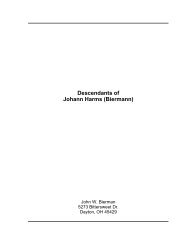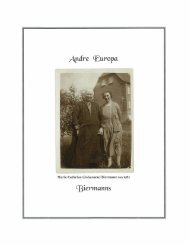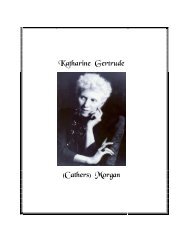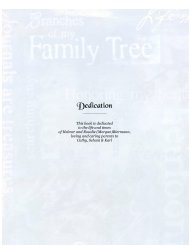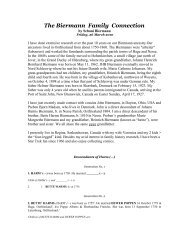A Collection of Dad's Essay's & Writings - Welcome
A Collection of Dad's Essay's & Writings - Welcome
A Collection of Dad's Essay's & Writings - Welcome
Create successful ePaper yourself
Turn your PDF publications into a flip-book with our unique Google optimized e-Paper software.
- Humour, Glories and the Name <strong>of</strong> Haydn -<br />
Franz Josef Haydn, who composed a number <strong>of</strong> fine masses, was also responsible for some interesting pieces <strong>of</strong><br />
music that are closely connected with the Christian Faith. One <strong>of</strong> these selections was a commission from the<br />
Cathedral in Cadiz, which requested a work to be performed during Lent in 1785.Haydn composed seven slow<br />
movements for a small orchestral ensemble based on and known as “The Seven Last Words <strong>of</strong> Christ on the Cross.”<br />
The Words were to be read and a sermon preached on each one <strong>of</strong> them. It must have been a long service since the<br />
composition is in excess <strong>of</strong> 50 minutes. Haydn also arranged the music for string quartet.<br />
Franz Josef Haydn, who somehow received the affectionate title “Papa”, was a prolific composer who wrote the<br />
music for the hymn tune generally known as the Austrian Hymn and found in the Lutheran Book <strong>of</strong> Worship as<br />
“Glories <strong>of</strong> Your Name are Spoken”. The melody has served as national anthems in both Imperial Austria and in<br />
Germany and at one time it served as the Royal anthem <strong>of</strong> Bulgaria.<br />
Haydn was born in Rohrau, Lower Austria in the year 1732 and died in Vienna in 1809. He composed over 100<br />
symphonies, 80 string quartets, 50 concertos, many piano selections, 24 operas, 12 masses and many songs. He had a<br />
shrewish wife, Anna Maria Keller, who once demanded that since he was making a bit <strong>of</strong> money a cottage should be<br />
built for her widowhood. Haydn did just that and enjoyed living in it for many years after his wife died. Even during<br />
their lifetime Haydn found many excuses not to spend too many hours in her presence. He did spend many years at<br />
Eisenstadt, across the border in Hungary, in the service <strong>of</strong> the fine princely family <strong>of</strong> Esterhazy in 1761 and remained<br />
with the family until 1790 and wrote a huge quantity <strong>of</strong> music while there. In those days the role <strong>of</strong> a composer was<br />
the same as any other household servant, although Haydn seemed to have been treated well and with kindness.<br />
There was one occasion when he and his musicians thought they deserved a holiday so they could go to their<br />
homes and visit family members. Haydn composed a symphony (No. 45 in F Minor) in which the musicians blew out<br />
their candles and left one at a time during the last movement until there was no-one left when the movement finished.<br />
It is reported that Prince Nicolaus Josef Esterhazy got the message. The symphony has since been known as the<br />
Farewell symphony and critics have evaluated it for its musical qualities rather than this romanticized story.<br />
One <strong>of</strong> his compositions, “A Mass in d Minor”, has become known as the Nelson Mass. Lord Horatio Nelson,<br />
later hero <strong>of</strong> the Battle <strong>of</strong> Trafalgar, once visited Franz Josef Haydn in 1800 at Eisenstadt where the composer was<br />
also paying a visit. Apparently Lord Nelson asked Haydn for his pen, which the composer gave him and received, in<br />
return, Nelson’s gold watch. The Mass was written in 1798 and for some obscure reason, it was called the Nelson Mass<br />
probably through some association with this visit which might have led to incorrect information. In England it is<br />
known as the “Coronation Mass” and in France, “Messe Imperiale”. One elderly lady remarked, when she saw a<br />
recording <strong>of</strong> the Nelson Mass: “Imagine, a Mass for that old reprobate.”<br />
There were a number <strong>of</strong> other masses composed by Haydn and apart from the numbers and the keys allotted to<br />
these sacred works many can be identified by specific names. The Mass No. 4 is known by “Missa St. Nicolai”; No. 5 is<br />
the “St. Joannis”; No. 7 has the title “Paukenmesse” and No. 10 is “The Resienmesse”, to honor the Empress Maria<br />
Theresa, wife <strong>of</strong> Francis II, who once sang the soprano part in the Haydn’s choral oratorio, The Seasons. This is not<br />
the famous Empress Maria Theresa who was greatly loved in Austria in the 18th century. The Missa Celensis No. 6 in<br />
C is known as “The Mariazellermesse”, named after the monastery in the village <strong>of</strong> Mariazell in Styria for which it was<br />
written. Haydn had made a pilgrimage to that monastery as a young man. The “Paukenmesse” (German for drum<br />
mass) was composed at the time when Napoleon was threatening Vienna in 1796 and there are some suggestions <strong>of</strong><br />
the threat <strong>of</strong> war. It has also been called after its Latin title “Missa in Tempore Belli”. The Mass No. 8 is “Heiligmesse”<br />
or the “Missa Sancti Bernardi von Offida”, a Capuchin monk from Italy who had recently been declared a Saint.<br />
In his later years Haydn was accorded many honors by various societies who vied for the chance to load him<br />
down with medals and diplomas. His visits to London were arranged by impresario, Johann P Salomon and he was<br />
amazed how much <strong>of</strong> a celebrity he was because <strong>of</strong> the advance publicity. It has been written that even the Prince <strong>of</strong><br />
Wales, (later Prince Regent and then King George IV) bowed to him and that at concerts the audience enthusiasm<br />
amounted to frenzy. For his London visit he wrote a number <strong>of</strong> Symphonies variously regarded as the London<br />
Symphonies or the Salomon Symphonies. One <strong>of</strong> the set was known as the Oxford, where he received a degree and the<br />
last, No. 104 was specifically called the London Symphony.<br />
What Haydn did not see was the squalor and destitution so ruthlessly depicted by Hogarth, but he was impressed<br />
by wealth and high living <strong>of</strong> the noble classes that had come about with the help <strong>of</strong> mercantile expansion and colonial<br />
expansion. During his visit to London the English publisher Bland came to visit Haydn while the latter was shaving<br />
and the composer exclaimed that he would give his best string quartet for a good razor. The publisher hurried out and<br />
came back with a fine set <strong>of</strong> razors made <strong>of</strong> the best English steel and Haydn gave him the “Quartet No. 62 in F<br />
Minor, op 55 No. 2”, which to this day is known as the “Razor Quartet”. The London visits were a huge succcess, but<br />
it has been written that Haydn objected to having his dinner late as the English did (6 p.m) and arranged to have his<br />
served at 4 p.m.



